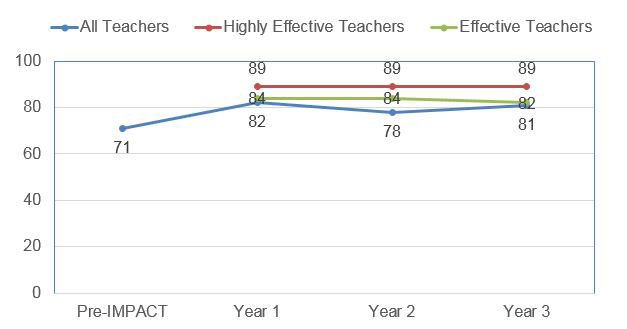 At the end of most days, when I left my classroom in one of the lowest-performing schools in Chicago, I felt like a failure, unsure if I had made progress with my students. And any progress I made was surely invisible, hidden under a mountain of failing test scores. I didn’t last very long—two years, and I was ready to pursue other career options.
At the end of most days, when I left my classroom in one of the lowest-performing schools in Chicago, I felt like a failure, unsure if I had made progress with my students. And any progress I made was surely invisible, hidden under a mountain of failing test scores. I didn’t last very long—two years, and I was ready to pursue other career options.
I was not alone, according to a new report from the Learning Policy Institute: nearly a quarter of teachers leave schools like mine by the end of their third year of teaching. Helping today’s invisible teachers see what progress they are or are not making with their students is important on many fronts. We have the tools, but we’re not using them.
Over half of teachers report some form of job dissatisfaction, often linked to assessments and accountability measures, according to the report. Linda Darling-Hammond, a co-author and founder of the Institute, told Politico, “teacher evaluation pressure made things worse because teachers could lose their jobs in a number of states.”
In my experience, the opposite is more likely true. Shielding teachers from information about their effectiveness isn’t motivating. Rather, it demoralizes teachers by making their contributions invisible, especially for good teachers in low-performing schools. Instead, to support, recognize, and retain teachers, we need to provide meaningful feedback using the best evaluation tools available. These tools should accurately measure the progress teachers make with their students on achievement tests and socio-emotional development.
Darling-Hammond is echoing a common refrain—our best teachers are fleeing schools because of accountability—but is it true? When given the opportunity, frustrated teachers may list any number of factors leading them to the exit door. The Learning Policy Institute report doesn’t show which factors actually matter. Instead, it shows that although teacher turnover rates were rising steadily between 1992 and 2005, they actually fell in each subsequent year through 2013, during the era of high-stakes teacher accountability policies. Of course, there are other possible explanations for these trends, including the Great Recession and subsequent economic recovery that occurred over this time period.
But there was no mass exodus when the District of Columbia Public Schools (DCPS) introduced the notoriously high-stakes IMPACT, under which teachers could receive performance pay or be fired based on their combined performance on multiple effectiveness measures. The overall retention rate of DCPS teachers actually increased the year after IMPACT was rolled out, and DCPS retained 89 percent of its most effective teachers in each of the first three years of IMPACT (See Figure). Also, in 10 other districts included in a rigorous study, pay-for-performance bonuses under the Teacher Incentive Fund improved teacher retention rates.

Source: “Longitudinal Analysis of DCPS Teachers” Table A.1
Notes: Retention rates by effectiveness category cannot be calculated before IMPACT because the categories were introduced with IMPACT. Year 1 of IMPACT is the 2009-2010 school year.
Despite the weight of the evidence, it seems logical to say that accountability pushes out good teachers. But to understand why it might not be, let me go back in time 15 years to my classroom in Chicago. Accountability has changed a lot since then. My school was in constant risk of being shut down for poor test scores (and actually was reconstituted shortly after I left), but relatively few individual teachers felt like their jobs were at risk.
Although high-stakes educator evaluations may be causing anxiety today, my anxiety actually came from the absence of evaluation. My “evaluation” was a one-page set of comments from my principal based on one or two 30-minute classroom observations. I think my principal thought she was being supportive by giving me high marks despite the obvious problems I was having with classroom management. But what I needed was real feedback about my effectiveness in the classroom. I wanted my students to succeed, but didn’t have the tools to measure their progress.
I did know my students’ test scores. They were low—very low. What I wanted to know was whether my students were making progress and whether I was making a difference in that growth. Specifically, if another teacher took my place, would my students be better or worse off? How much was I contributing to my students’ learning, compared to an average teacher in the district? But because any progress my students made was unmeasured, like many teachers in similar settings, I felt invisible.
Today, the situation is different. Teachers in many states and districts are given information, such as their value-added results, about their individual contributions to student test scores. When the focus shifts from achievement levels like proficiency rates, to achievement gains like value-added results, teachers in the lowest-performing schools can suddenly be identified as high performers. In other words, we can start to see progress that previously just looked like failure.
The invisible nature of teachers’ impact has motivated my work developing measures of teachers’ contributions to achievement. I want teachers in the most challenging school environments to know when they are making progress. We owe it to them to recognize and reward their progress—to remove the cloak of invisibility that hides their contributions. Identifying and retaining effective teachers in these environments is critical to improving their students’ educational outcomes. And so is identifying less effective teachers, providing them with support to help them improve, and eventually replacing them if that fails.
To support, recognize, and retain teachers, we need to use the best evaluation tools available. Unfortunately, few states or districts are doing that. Some rely exclusively on classroom observations, which have improved from when I was in the classroom, but are stacked against teachers of low-performing students because observers do not separate the context in which a teacher works from teacher performance. Others provide teachers with crude measures of student gains despite the evidence that these measures often penalize teachers of disadvantaged students. Even student growth percentiles based on a relatively sophisticated approach that is used in many states have been shown to underestimate the progress teachers make with disadvantaged students. But rigorous research demonstrates that some value-added models, like those that have been used in DCPS, Pittsburgh, Charleston, Oklahoma, and New York City, better account for students’ skills and background when they enter a teacher’s classroom, and provide important information about teachers’ contributions to student achievement.
But that message is not getting through. States like Oklahoma have backed away from calculating value-added results. California recently proposed changes to its method of evaluating schools. Until recently, the state set proficiency targets for schools, similar to what Chicago did while I was teaching. But rather than taking a careful look at how best to measure what is actually going on in classrooms, California plans to double down on these old methods and set new targets for a whole slew of measures, including high school graduation and suspension rates.
This sounds familiar to me. Once again, the contributions of hard-working teachers in schools like mine will be invisible. This is not a recipe for retaining our best educators. The new federal education law, the Every Student Succeeds Act (ESSA), gives states the freedom and flexibility to develop their own accountability systems. States will need to voluntarily do the heavy lifting needed to give their teachers meaningful feedback and shine a light on the invisible teachers.


